Jaguar E-Pace vs Jeep Grand Cherokee – Which one offers the better deal?
Everyday use, family trips or long-distance drives – here’s where the differences show.
Discover whether Jaguar E-Pace or Jeep Grand Cherokee fits your lifestyle better.
Costs and Efficiency:
Price and efficiency are often the first things buyers look at. Here it becomes clear which model has the long-term edge – whether at the pump, the plug, or in purchase price.
Jaguar E-Pace has a clearly advantage in terms of price – it starts at 32400 £, while the Jeep Grand Cherokee costs 85600 £. That’s a price difference of around 53228 £.
Fuel consumption also shows a difference: Jaguar E-Pace manages with 1.40 L and is therefore clearly more efficient than the Jeep Grand Cherokee with 2.90 L. The difference is about 1.50 L per 100 km.
As for range, the Jaguar E-Pace performs distinct better – achieving up to 69 km, about 24 km more than the Jeep Grand Cherokee.
Engine and Performance:
Power, torque and acceleration are the classic benchmarks for car enthusiasts – and here, some clear differences start to show.
When it comes to engine power, the Jeep Grand Cherokee has a distinct edge – offering 380 HP compared to 269 HP. That’s roughly 111 HP more horsepower.
In acceleration from 0 to 100 km/h, the Jeep Grand Cherokee is to a small extent quicker – completing the sprint in 6.30 s, while the Jaguar E-Pace takes 7.30 s. That’s about 1 s faster.
In terms of top speed, the Jaguar E-Pace performs slight better – reaching 211 km/h, while the Jeep Grand Cherokee tops out at 210 km/h. The difference is around 1 km/h.
There’s also a difference in torque: Jeep Grand Cherokee pulls to a small extent stronger with 637 Nm compared to 540 Nm. That’s about 97 Nm difference.
Space and Everyday Use:
Cabin size, boot volume and payload all play a role in everyday practicality. Here, comfort and flexibility make the difference.
Both vehicles offer seating for 5 people.
In curb weight, Jaguar E-Pace is clearly perceptible lighter – 1783 kg compared to 2434 kg. The difference is around 651 kg.
In terms of boot space, the Jeep Grand Cherokee offers hardly perceptible more room – 520 L compared to 494 L. That’s a difference of about 26 L.
In maximum load capacity, the Jeep Grand Cherokee performs decisively better – up to 2004 L, which is about 834 L more than the Jaguar E-Pace.
When it comes to payload, Jeep Grand Cherokee to a small extent takes the win – 641 kg compared to 554 kg. That’s a difference of about 87 kg.
Who wins the race?
The Jaguar E-Pace proves to be is largely superior and therefore becomes our DriveDuel Champion!
Jaguar E-Pace is the better all-rounder in this comparison.

Jaguar E-Pace
Jaguar E-Pace
The Jaguar E-Pace is a compact SUV that combines the brand's signature luxury with a dynamic driving experience. Its sleek design features graceful lines and an assertive stance, making it a standout on any road. Inside, the E-Pace boasts a meticulously crafted interior with high-quality materials and advanced technology, providing both comfort and connectivity for drivers and passengers alike.
details @ media.jaguar.com
@ media.jaguar.com
 @ media.jaguar.com
@ media.jaguar.com
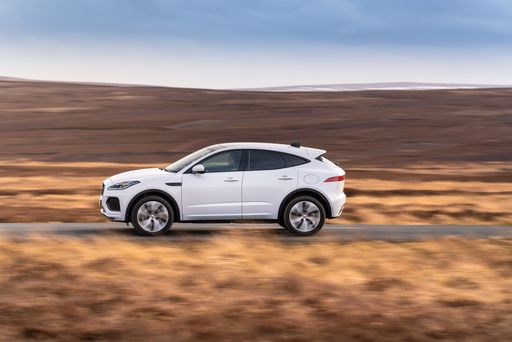 @ media.jaguar.com
@ media.jaguar.com
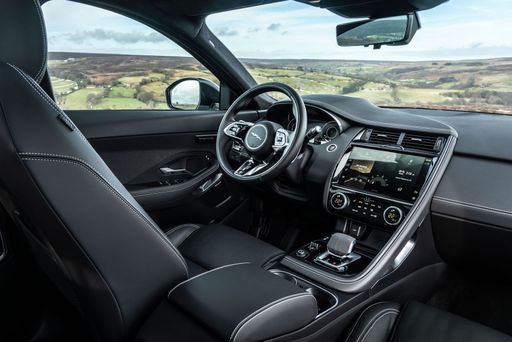 @ media.jaguar.com
@ media.jaguar.com
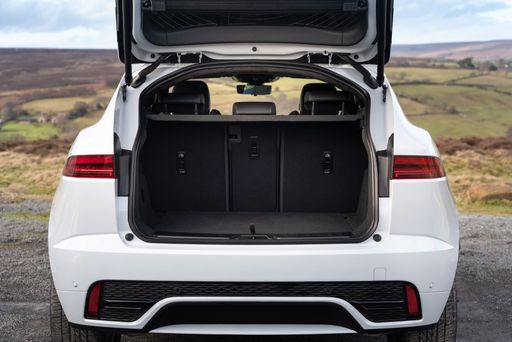 @ media.jaguar.com
@ media.jaguar.com
Jeep Grand Cherokee
The Jeep Grand Cherokee impresses with its blend of rugged capability and refined elegance, making it a versatile choice for both off-road adventures and urban settings. Its spacious interior is complemented by high-quality materials and advanced technology, ensuring comfort and connectivity on every journey. With a strong reputation for performance, this SUV continues to uphold Jeep's legacy of delivering vehicles that are both powerful and reliable.
details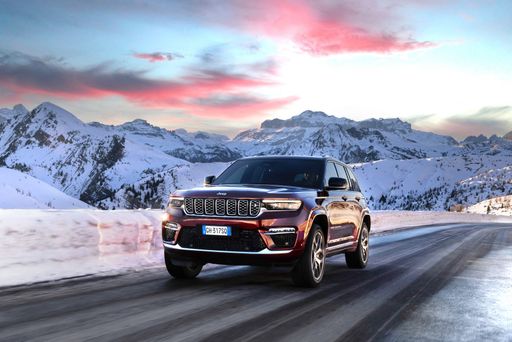 @ media.stellantis.com
@ media.stellantis.com
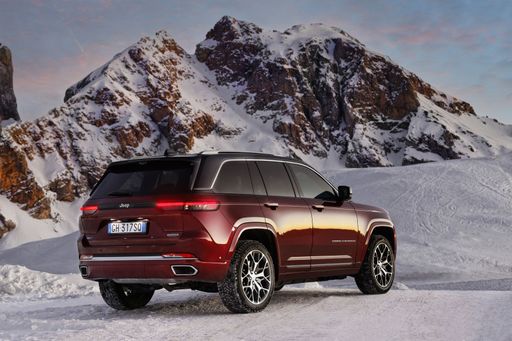 @ media.stellantis.com
@ media.stellantis.com
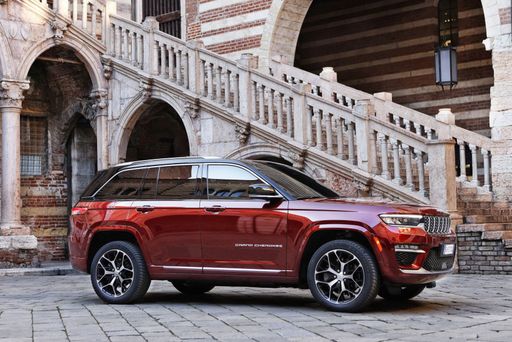 @ media.stellantis.com
@ media.stellantis.com
 @ media.stellantis.com
@ media.stellantis.com

|

|
|
|
|
Costs and Consumption |
|
|---|---|
|
Price
32400 - 56100 £
|
Price
85600 £
|
|
Consumption L/100km
1.4 - 8.2 L
|
Consumption L/100km
2.90 L
|
|
Consumption kWh/100km
-
|
Consumption kWh/100km
-
|
|
Electric Range
69 km
|
Electric Range
45 km
|
|
Battery Capacity
11.50 kWh
|
Battery Capacity
-
|
|
co2
33 - 185 g/km
|
co2
65 g/km
|
|
Fuel tank capacity
56 - 67 L
|
Fuel tank capacity
72 L
|
Dimensions and Body |
|
|---|---|
|
Body Type
SUV
|
Body Type
SUV
|
|
Seats
5
|
Seats
5
|
|
Doors
5
|
Doors
5
|
|
Curb weight
1783 - 2173 kg
|
Curb weight
2434 kg
|
|
Trunk capacity
494 L
|
Trunk capacity
520 L
|
|
Length
4395 mm
|
Length
4914 mm
|
|
Width
1984 mm
|
Width
1968 mm
|
|
Height
1648 mm
|
Height
1858 mm
|
|
Max trunk capacity
1170 L
|
Max trunk capacity
2004 L
|
|
Payload
497 - 554 kg
|
Payload
641 kg
|
Engine and Performance |
|
|---|---|
|
Engine Type
Plugin Hybrid, Diesel MHEV, Petrol MHEV
|
Engine Type
Plugin Hybrid
|
|
Transmission
Automatic
|
Transmission
Automatic
|
|
Transmission Detail
Automatic Gearbox
|
Transmission Detail
Automatic Gearbox
|
|
Drive Type
All-Wheel Drive, Front-Wheel Drive
|
Drive Type
All-Wheel Drive
|
|
Power HP
160 - 269 HP
|
Power HP
380 HP
|
|
Acceleration 0-100km/h
7.3 - 10.5 s
|
Acceleration 0-100km/h
6.30 s
|
|
Max Speed
190 - 211 km/h
|
Max Speed
210 km/h
|
|
Torque
260 - 540 Nm
|
Torque
637 Nm
|
|
Number of Cylinders
3 - 4
|
Number of Cylinders
4
|
|
Power kW
118 - 198 kW
|
Power kW
280 kW
|
|
Engine capacity
1498 - 1998 cm3
|
Engine capacity
1995 cm3
|
General |
|
|---|---|
|
Model Year
2024
|
Model Year
2024
|
|
CO2 Efficiency Class
B, G
|
CO2 Efficiency Class
B
|
|
Brand
Jaguar
|
Brand
Jeep
|
What drive types are available for the Jaguar E-Pace?
The Jaguar E-Pace is offered with All-Wheel Drive or Front-Wheel Drive.
The prices and data displayed are estimates based on German list prices and may vary by country. This information is not legally binding.
